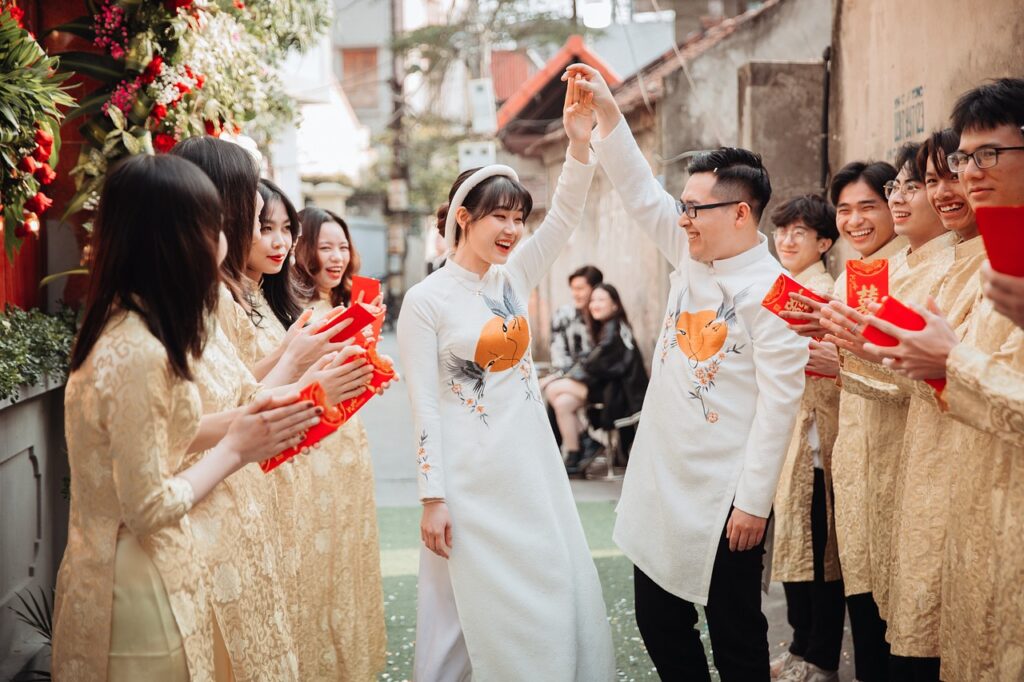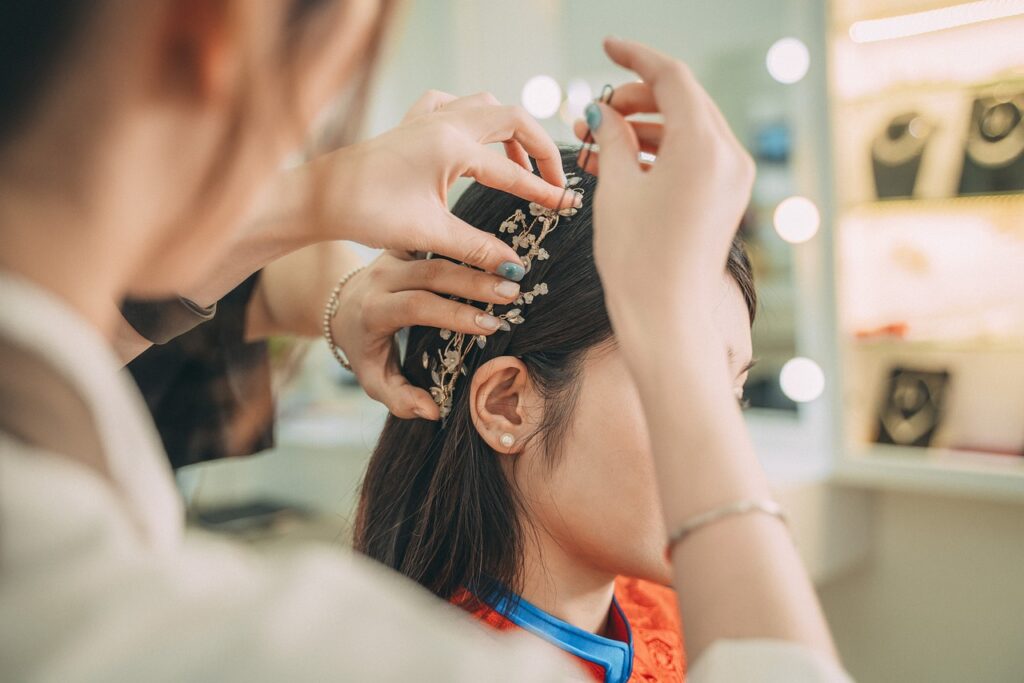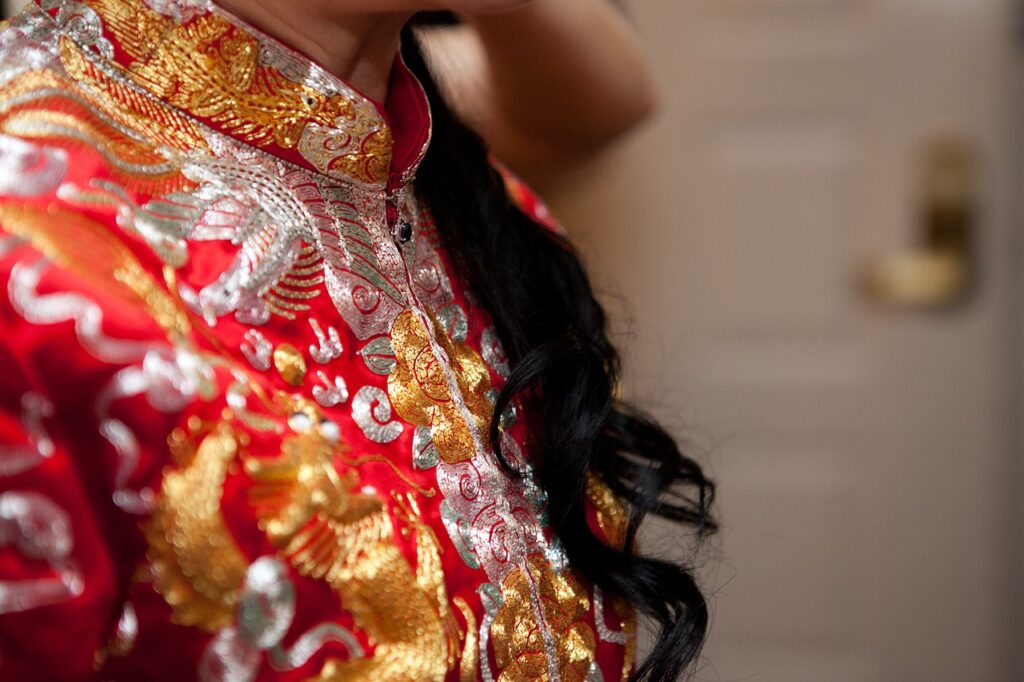Chinese weddings are steeped in cultural traditions that have been passed down through generations. Each ritual is imbued with deep symbolic meaning, reflecting the values and beliefs of Chinese culture. In this post, we will explore twelve significant Chinese wedding traditions, delving into their origins, meanings, and the roles they play in modern Chinese weddings.
1.Proposal and Betrothal Gifts
In traditional Chinese culture, the wedding process begins with the proposal and the exchange of betrothal gifts. The groom’s family sends a formal proposal to the bride’s family, accompanied by a set of gifts known as “聘礼” (pìn lǐ). These gifts typically include money, jewelry, and other valuables, symbolizing the groom’s sincerity and ability to provide for the bride. The bride’s family then reciprocates with their own set of gifts, sealing the engagement and marking the start of wedding preparations.

2. Choosing the Wedding Date
Selecting an auspicious date for the wedding is a critical step in Chinese wedding planning. The date is chosen based on the lunar calendar, considering factors such as the couple’s zodiac signs and the phases of the moon. The chosen date is believed to bring good fortune, happiness, and prosperity to the couple. Families often consult a fortune-teller or a Chinese almanac known as the “Tong Shu” (通书) to determine the best day for the wedding.
3. Hair Combing Ceremony
The hair combing ceremony, known as “上头” (shàng tóu), is a ritual that takes place the night before the wedding. Both the bride and groom participate in this ceremony separately in their own homes. Their parents or elder relatives comb their hair while reciting blessings, symbolizing the couple’s transition from childhood to adulthood. This ceremony is meant to bring good luck, longevity, and a harmonious marriage.

4. Bridal Dowry
The bride’s family prepares a dowry, known as “嫁妆” (jià zhuāng), which consists of items that the bride will bring to her new home. The dowry typically includes furniture, household items, and personal belongings, all chosen to ensure the bride’s comfort and well-being in her new life. The dowry is displayed in the bride’s home before being transported to the groom’s house, symbolizing the family’s support and blessings for the bride.
5. Wedding Door Games
On the wedding day, the groom and his groomsmen must pass a series of “door games” (闯门, chuǎng mén) set up by the bridesmaids to test his love and determination to marry the bride. These games can include playful challenges, riddles, and tasks that the groom must complete before he is allowed to see his bride. This tradition adds an element of fun to the wedding day and symbolizes the groom’s dedication to overcoming obstacles for his beloved.
6. Tea Ceremony
The tea ceremony, known as “敬茶” (jìng chá), is one of the most important rituals in a Chinese wedding. The bride and groom serve tea to their parents and elder relatives as a gesture of respect and gratitude. In return, the couple receives blessings and gifts, often in the form of red envelopes (红包, hóng bāo) containing money or jewelry. This ceremony symbolizes the union of two families and the couple’s filial piety.
7. Red Color Theme
Red is a dominant color in Chinese weddings, symbolizing happiness, prosperity, and good fortune. The bride typically wears a red wedding dress, known as “旗袍” (qí páo) or “褂” (guà), adorned with intricate embroidery. Red decorations, including lanterns, banners, and ribbons, are used throughout the wedding venue to create a festive atmosphere. The use of red extends to various elements of the wedding, including invitations, envelopes, and even the wedding cake.

8. Dragon and Phoenix Candles
During the wedding ceremony, the couple lights a pair of candles known as the “龙凤烛” (lóng fèng zhú), or dragon and phoenix candles. These candles represent the bride and groom, with the dragon symbolizing the groom and the phoenix symbolizing the bride. Lighting these candles signifies the merging of two families and the couple’s wish for a harmonious and prosperous marriage.
9. Traditional Attire
In addition to the red wedding dress, the bride may also wear a “鳳冠霞帔” (fèng guān xiá pèi), a traditional Chinese wedding headdress and robe. The groom typically wears a “长袍马褂” (cháng páo mǎ guà), a long robe and jacket. These traditional outfits are often adorned with elaborate designs and embroidery, showcasing the couple’s heritage and adding to the grandeur of the occasion.
10. Wedding Banquet
The wedding banquet, known as “喜宴” (xǐ yàn), is a lavish feast that celebrates the union of the couple and honors their families and friends. The banquet usually consists of multiple courses, featuring auspicious foods such as fish, symbolizing abundance, and sweet desserts, representing a sweet and harmonious marriage. Speeches, toasts, and entertainment, such as lion dances and traditional music, add to the festive atmosphere.
11. Firecrackers and Lion Dance
To ward off evil spirits and bring good luck, firecrackers are often set off during Chinese wedding celebrations. The loud noise is believed to scare away negative energies and ensure a positive start to the couple’s married life. Additionally, a lion dance performance, featuring vibrant costumes and energetic movements, is commonly included to bring joy and prosperity to the couple and their guests.
12. Bed Setting Ceremony
The bed setting ceremony, known as “安床” (ān chuáng), takes place before the wedding day. A “good luck woman,” often a woman with a healthy family and many children, is chosen to set up the couple’s bed. The bed is adorned with auspicious items such as red bedsheets, dragon and phoenix pillows, and fruits like dates and lotus seeds, symbolizing fertility and a happy marriage. This ceremony is meant to bless the couple with a harmonious and prosperous union.
Conclusion
Chinese wedding traditions are a beautiful blend of cultural heritage and symbolic rituals that reflect the values and beliefs of Chinese society. Each tradition, from the proposal and betrothal gifts to the bed setting ceremony, plays a crucial role in ensuring the couple’s happiness, prosperity, and harmony. By understanding and honoring these traditions, couples can create a meaningful and memorable wedding that celebrates their love and cultural roots.
